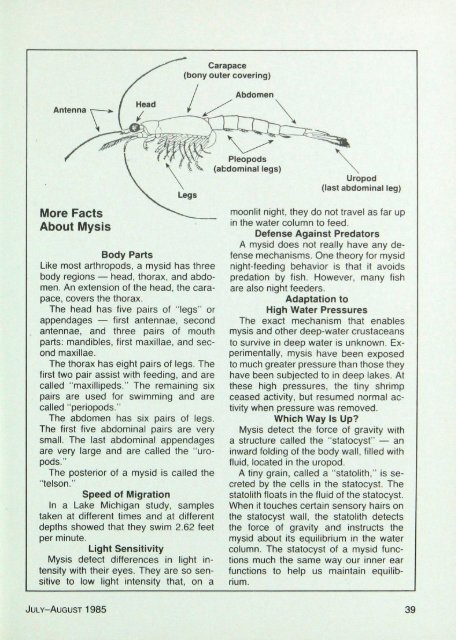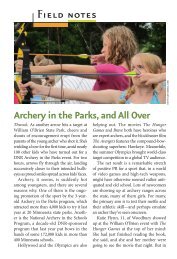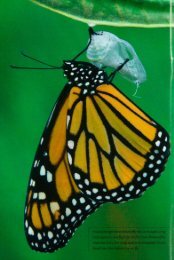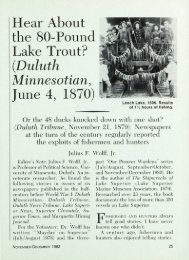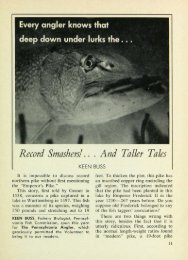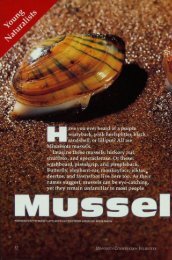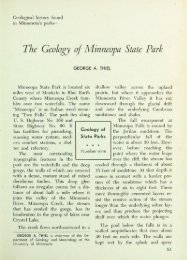501 Extraordinary Journey of the Opossum Shrimp - webapps8
501 Extraordinary Journey of the Opossum Shrimp - webapps8
501 Extraordinary Journey of the Opossum Shrimp - webapps8
Create successful ePaper yourself
Turn your PDF publications into a flip-book with our unique Google optimized e-Paper software.
Carapace<br />
(bony outer covering)<br />
Antenna<br />
Uropod<br />
(last abdominal leg)<br />
More Facts<br />
About Mysis<br />
Body Parts<br />
Like most arthropods, a mysid has three<br />
body regions — head, thorax, and abdomen.<br />
An extension <strong>of</strong> <strong>the</strong> head, <strong>the</strong> carapace,<br />
covers <strong>the</strong> thorax.<br />
The head has five pairs <strong>of</strong> "legs" or<br />
appendages — first antennae, second<br />
antennae, and three pairs <strong>of</strong> mouth<br />
parts: mandibles, first maxillae, and second<br />
maxillae.<br />
The thorax has eight pairs <strong>of</strong> legs. The<br />
first two pair assist with feeding, and are<br />
called "maxillipeds." The remaining six<br />
pairs are used for swimming and are<br />
called "periopods."<br />
The abdomen has six pairs <strong>of</strong> legs.<br />
The first five abdominal pairs are very<br />
small. The last abdominal appendages<br />
are very large and are called <strong>the</strong> "uropods."<br />
The posterior <strong>of</strong> a mysid is called <strong>the</strong><br />
"telson."<br />
Speed <strong>of</strong> Migration<br />
In a Lake Michigan study, samples<br />
taken at different times and at different<br />
depths showed that <strong>the</strong>y swim 2.62 feet<br />
per minute.<br />
Light Sensitivity<br />
Mysis detect differences in light intensity<br />
with <strong>the</strong>ir eyes. They are so sensitive<br />
to low light intensity that, on a<br />
moonlit night, <strong>the</strong>y do not travel as far up<br />
in <strong>the</strong> water column to feed.<br />
Defense Against Predators<br />
A mysid does not really have any defense<br />
mechanisms. One <strong>the</strong>ory for mysid<br />
night-feeding behavior is that it avoids<br />
predation by fish. However, many fish<br />
are also night feeders.<br />
Adaptation to<br />
High Water Pressures<br />
The exact mechanism that enables<br />
mysis and o<strong>the</strong>r deep-water crustaceans<br />
to survive in deep water is unknown. Experimentally,<br />
mysis have been exposed<br />
to much greater pressure than those <strong>the</strong>y<br />
have been subjected to in deep lakes. At<br />
<strong>the</strong>se high pressures, <strong>the</strong> tiny shrimp<br />
ceased activity, but resumed normal activity<br />
when pressure was removed.<br />
Which Way Is Up?<br />
Mysis detect <strong>the</strong> force <strong>of</strong> gravity with<br />
a structure called <strong>the</strong> "statocyst" — an<br />
inward folding <strong>of</strong> <strong>the</strong> body wall, filled with<br />
fluid, located in <strong>the</strong> uropod.<br />
A tiny grain, called a "statolith," is secreted<br />
by <strong>the</strong> cells in <strong>the</strong> statocyst. The<br />
statolith floats in <strong>the</strong> fluid <strong>of</strong> <strong>the</strong> statocyst.<br />
When it touches certain sensory hairs on<br />
<strong>the</strong> statocyst wall, <strong>the</strong> statolith detects<br />
<strong>the</strong> force <strong>of</strong> gravity and instructs <strong>the</strong><br />
mysid about its equilibrium in <strong>the</strong> water<br />
column. The statocyst <strong>of</strong> a mysid functions<br />
much <strong>the</strong> same way our inner ear<br />
functions to help us maintain equilibrium.<br />
JULY-AUGUST 1985 39


